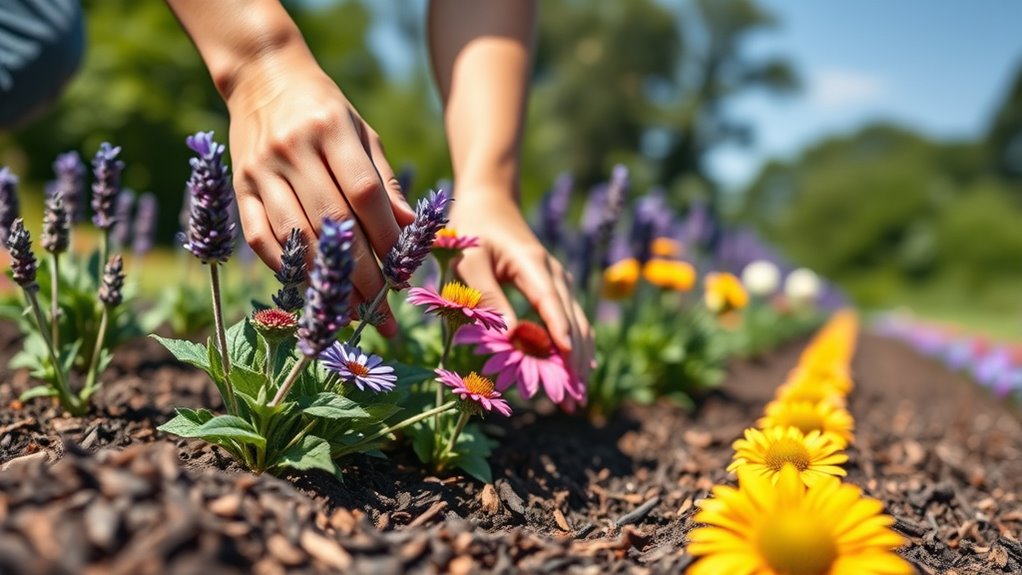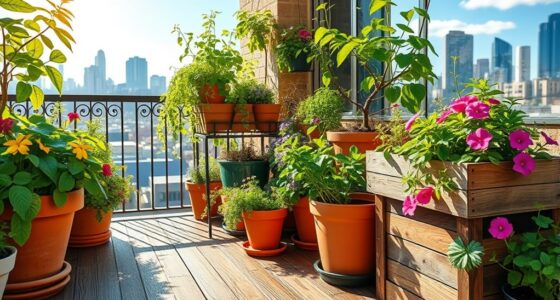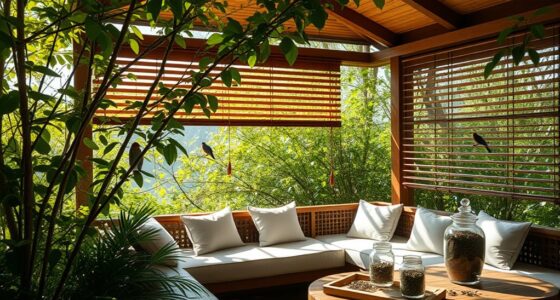To plant low-maintenance perennials, start by selecting native or drought-tolerant varieties suited to your climate for easier care. Prepare your soil with compost, guarantee proper spacing, and plant at the recommended depth. Group plants with similar needs, and use mulch to suppress weeds and retain moisture. Water deeply but infrequently to encourage strong roots, and keep up with minimal pruning and deadheading. Continue exploring to discover more tips for a vibrant, effortless garden.
Key Takeaways
- Choose native or well-adapted perennials with proven durability and low water needs for easier maintenance.
- Group plants with similar sunlight, water, and soil requirements to simplify care and optimize growth.
- Prepare soil with compost and ensure proper spacing to promote healthy roots and reduce future problems.
- Incorporate mulch to suppress weeds, retain moisture, and minimize watering and weeding efforts.
- Select plants with overlapping bloom times for continuous color and minimal intervention throughout seasons.

If you’re looking to enjoy a vibrant garden with minimal effort, low-maintenance perennials are an excellent choice. These plants require less watering, pruning, and replanting, freeing you up to relax and enjoy your outdoor space. To get the most out of your garden, start with thoughtful garden bed design. Consider arranging your perennials based on their growth habits, sunlight needs, and bloom times. Grouping plants with similar requirements ensures they thrive together and reduces the need for constant adjustments. Use layering techniques—place taller varieties at the back and shorter ones in front—to create a visually appealing, easy-to-maintain landscape. Incorporate mulch around your plants to suppress weeds, retain moisture, and keep your garden looking tidy with less effort. Additionally, choosing diverse designs and plant varieties can add visual interest and help your garden stand out with minimal additional work.
Design your garden with layered plant heights and grouped perennials for easy, beautiful maintenance.
When it comes to perennial selection tips, focus on choosing native species or well-adapted varieties suited to your climate. Native perennials tend to be more resilient and require less maintenance because they’re naturally adapted to your environment. Opt for plants with a proven track record for durability and low water needs, which will save time and resources over the seasons. Consider plants that are pest and disease resistant to avoid frequent treatments and interventions. It’s also wise to select a mix of bloom times to ensure continuous color throughout the growing season, reducing the need for replacement or extra planting.
Plant your perennials in well-prepared soil, enriching it with compost to provide a healthy foundation. Proper spacing is essential—crowded plants can struggle and become more susceptible to problems, increasing your workload. Follow planting instructions carefully, as depth and spacing influence growth and longevity. Once established, many low-maintenance perennials require minimal fertilizing; a light application of slow-release fertilizer in early spring is often sufficient. Water deeply and infrequently rather than frequently, encouraging deep root growth and drought tolerance. This approach minimizes watering needs and helps your plants withstand dry spells.
Lastly, keep an eye on your garden’s overall health but avoid over-intervening. Remove dead or damaged foliage to maintain aesthetics and prevent disease, but resist the urge to over-prune or fuss over your plants. With a strategic garden bed design and careful perennial selection, you’ll cultivate a lush, colorful garden that demands little upkeep, leaving you more time to enjoy your outdoor oasis.
Frequently Asked Questions
Which Perennials Are Best for Shady Areas?
If you’re looking for shade lovers, consider perennial choices like hostas, ferns, and astilbes. These plants thrive in shady areas and require minimal maintenance. You’ll enjoy their lush foliage and beautiful flowers without much effort. Plant them in well-drained soil, water when needed, and they’ll flourish. These low-maintenance perennials are perfect for adding greenery and color to shaded spots in your garden.
How Often Should I Water Low-Maintenance Perennials?
You should water your low-maintenance perennials once a week during their first growing season to establish strong roots. After that, they typically only need watering during prolonged dry spells, thanks to their drought tolerance. Keep an eye on soil moisture; if it feels dry a few inches down, give them a deep watering. Adjust your watering schedule based on weather conditions to make certain your plants stay healthy.
Can These Perennials Survive Extreme Weather Conditions?
Like a resilient warrior, your perennials stand firm against extreme weather. Many are drought-tolerant, thriving in dry spells, and wind-resistant, enduring gusts that shake lesser plants. Though they can handle tough conditions, giving them some extra care during severe weather helps them bounce back faster. With proper selection, your low-maintenance perennials can survive and even flourish through heatwaves, cold snaps, or fierce winds—standing tall no matter what Mother Nature throws their way.
Are Low-Maintenance Perennials Deer-Resistant?
Yes, many low-maintenance perennials are deer-resistant, making them great choices for your garden. To enhance deer resistance, choose varieties known for their deterrent qualities and follow maintenance tips like avoiding over-fertilizing, which can attract deer. Regularly inspect your plants, and consider adding natural repellents if deer become a problem. With proper care, these perennials will thrive while minimizing deer damage, keeping your garden vibrant and easy to maintain.
What Soil Types Are Ideal for These Plants?
You should prepare well-draining soil with a mix of organic matter to meet the nutrient requirements of low-maintenance perennials. They thrive in loamy soils that balance moisture retention and drainage, but some tolerate sandy or clay soils with proper amendments. Focus on soil preparation by testing and amending it as needed, ensuring it’s rich in nutrients and well-drained, so your perennials can establish strong roots and flourish with minimal upkeep.
Conclusion
Planting low-maintenance perennials is a smart move that pays off in the long run. They’ll give your garden color and life without demanding constant attention, making gardening more enjoyable and less of a chore. Once you choose the right ones, you’re all set for a beautiful, hassle-free landscape. Remember, it’s better to have a little patience now than to fight an uphill battle later. Sometimes, the best things in life are worth waiting for.









